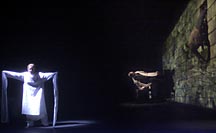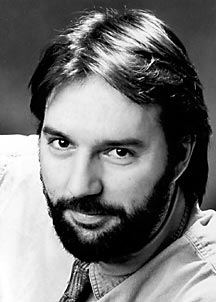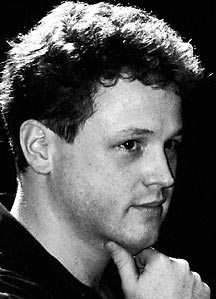Opéra de Montréal by MISHA ASTER
/ March 6, 2004
Version française...
Erwartung /Bluebeard's
Castle
"Snow, squirrels, 90 TV channels,hundreds of kinds of cereal..."
 Gregory Vajda still has a few vivid
memories of his first trip to Montreal. In 1985, 12-year old Vajda and his
father travelled from their native Budapest to Canada to hear his mother,
soprano Veronika Kincses, sing Mimi in L'Opéra de Montréal's production of La
Bohème. Almost 20 years later, Vajda is preparing for his own debut at
L'Opéra de Montréal, conducting Robert Lepage's critically acclaimed double-bill
production of Bartok's Duke Bluebeard's Castle and Schoenberg's
Erwartung, opening March 13 at Place des Arts. For Maestro Vajda, this is
a special debut not only because of his fond childhood memories but also because
he will introduce music that is deeply connected to his own sense of Central
European heritage. Gregory Vajda still has a few vivid
memories of his first trip to Montreal. In 1985, 12-year old Vajda and his
father travelled from their native Budapest to Canada to hear his mother,
soprano Veronika Kincses, sing Mimi in L'Opéra de Montréal's production of La
Bohème. Almost 20 years later, Vajda is preparing for his own debut at
L'Opéra de Montréal, conducting Robert Lepage's critically acclaimed double-bill
production of Bartok's Duke Bluebeard's Castle and Schoenberg's
Erwartung, opening March 13 at Place des Arts. For Maestro Vajda, this is
a special debut not only because of his fond childhood memories but also because
he will introduce music that is deeply connected to his own sense of Central
European heritage.
When discussing his background, Vajda speaks
effusively to Montreal audiences about the great Hungarian musical tradition
which he feels a part of, from Bartok, Kodaly and Dohnanyi to Kurtag, Eotvos and
Ligeti. Like many of his important predecessors, Vajda is both a performer and
composer, putting him in an exceptional category among conductors
today.
It was initially through leading performances of
his own music that Vajda grew into a conductor. During his studies in Budapest
he came under the influence of composer-conductor Peter Eotvos, from whom he
learned "a technique of conducting and how to rehearse a piece, how to treat
singers and musicians. I read and learn scores quickly, and approach everything
like a world premiere."
Unique diction
The most distinctive characteristic of Hungarian
music, says Vajda, is its unique diction. "Singers have to face it, of course,
but the Hungarian language deeply influences instrumental writing as well."
Hungarian, distantly related to Finnish, is a highly rhythmic language, with
strong accents usually falling on the first syllable of words and the beginning
of sentences. "Hungarian diction affects composers' thinking in terms of melody
and rhythm, and in Bartok's music, there is also the added influence of folk
culture." In Duke Bluebeard's Castle, these folk influences are heard
throughout.
Duke Bluebeard's Castle--Bartok's only
opera--is one of the significant cornerstones of his oeuvre. "You can hear a lot
of Richard Strauss in the opera, and feel the presence of the Romantic tradition
as well as the Hungarian characteristics." In terms of orchestration and use of
musical metaphor, Duke Bluebeard's Castle reveals these Romantic
connections. "The first gate (the torture chamber) features a high clarinet; the
brass instruments in the fifth gate (landscape with red clouds); the lake of
tears (sixth gate), the harp. When the Duke is talking about his three former
wives, the music continues to rise suggestively in tonality. It is one of the
most beautiful parts of the opera."
This post-Romantic musical-dramatic detailing is
one of the more significant similarities between Bartok's opera and Arnold
Schoenberg's "monodrama." Erwartung was written in 1909, two years prior
to Duke Bluebeard's Castle. Although there is no evidence to suggest
Bartok was aware of Schoenberg's work, "there seems to have been something in
the air at that time that brought out these qualities of expressionism,
symbolism, and metaphor--searching for a language of psychology in music."
Indeed, for many years Schoenberg himself attended regular sessions with the
"father of psychoanalysis," Dr. Sigmund Freud, and was deeply involved in the
artistic, literary and scientific vanguard exploring the boundaries of human
consciousness at the turn of the 20th Century.
For Vajda, however, it is Schoenberg's artistry
that is so remarkable. "The reason I like the music of this part of Schoenberg's
life so much is because it is not about systems or theory, but always about
music. Erwartung is a short piece--perhaps 35 minutes--but can feel much
longer because it is so deep, so dense." Compositionally, Schoenberg's
considerations were very similar to those of Bartok. "For me, the operas are two
sides of the same problem. One from the man's side (Bluebeard), the other
from the woman's (Erwartung). They are both about people unable to be
together, but also unable to live without each other. One hears these
pessimistic, tragic tensions very clearly in the music."
 A giant improvisation A giant improvisation
Vajda describes conducting Schoenberg's score as
leading a giant improvisation. Erwartung is composed in a very open form,
corresponding to the protagonist's free stream of consciousness. "Of course the
music is very precisely written, and practically speaking, everything must be
very strictly fixed with the singer and orchestra in rehearsals, but in
performance you go with the flow to achieve a very flexible, spontaneous
style."
The singer in Erwartung (named simply "The
Woman") contributes to the impulsive impression of the work through the
seemingly free shifting of her voice, from whispered speech to full-throttle
operatic singing. Much of the work calls for a style especially developed by
Schoenberg, called Sprechgesang, which is a type of heightened speech
scored with X's and arrows across the musical staff, akin in many respects to
the earlier operatic convention of recitativo.
Schoenberg, like Bartok, was very aware of his
musical predecessors in composing Erwartung. Aside from the classical
recitativo influence, Richard Wagner still looms large in terms of
harmonic construction, while Gustav Mahler "influences the whole orchestral
sound colour" of the work. Especially remarkable features include moments
calling for the woodwind players to lift their instruments, providing a
"shrieky" effect, and the use of a harp prepared with little pieces of paper to
create a particularly haunting sound.
Lepage's version
The expressionistic world of atmospheric colours
and effects is evoked not just musically, but also imagistically in the
critically acclaimed Robert Lepage production of Duke Bluebeard's
Castle-Erwartung this March. Since it was first premiered in Toronto
in 1992, Lepage's production has been remounted eight times worldwide. "The
success of this production," says François Racine, the director responsible for
recreating Lepage's staging for every production since 1992, "comes from the
brilliant way it blends together the expressionist sense of emotional breakdown
with powerful visual images. Michael Levine (the set designer) designed this
huge frame around the set that suggests a painting by Klimt." The idea is to
evoke Klimt, Freud, Vienna, and that era of expressionism.
Visual and musical expression
Within the imaginative theatrical world created by
Lepage, Levine, and their lighting designer Rob Thompson, the dramatic and
psychological tensions evoked musically also find visual expression. Says
Racine, "The space of Bluebeard is very closed and dark, giving a
powerful sense of physical claustrophobia, with the doors just providing a
glimpse of what is outside. Erwartung, by contrast, is a very open space,
with just one wall, and a lot of light, but the piece still conveys a sense of
mental claustrophobia. The woman's hallucinations encroach upon her. This theme
of enclosure, physical in the first, internal in the second, is very important
to the production."
When he first heard the music, Racine says, the
Bartok struck him as being "an enormous wave of music," the Schoenberg as
"conveying a sense of very touching passion." He admits that both pieces are
musically and thematically challenging, "but once you start to overlap the music
with images on stage, it becomes very powerful. The imagery is so well supported
by the music, you do not remark, 'It's weird music,' you just get carried away
by the total impact."
Lepage's version has had more than a decade of
outstanding critical and popular success across the globe. Now Montreal
audiences will finally get a chance to experience this unique musical-theatrical
spectacle for themselves. For Lepage, Racine, and in a special sense for Maestro
Vajda too, this promises to be an exceptional homecoming.
Photo 1 caption: Gregory
Vajda
Photo 2 caption: François
Racine
Version française... |
|


